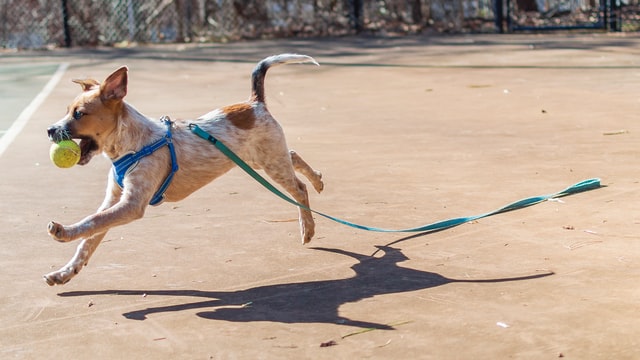A dog is an excellent choice as a companion when going out on walks or even for a jog. Not only will you have the much-needed exercise, but your dog will also benefit in attaining a healthy physical and mental state. But before you head out the door with your loyal pet, let us determine if a dog harness is better than a collar.
Dog harnesses and dog collars are used to control and restrain dogs, especially when walking outdoors or during training. It is believed that it was royalty that first began the use of dog collars as the status of the dog became popular, and dog ownership became widespread.
Dog Harness
A dog harness is composed of straps that loop around the torso of the dog. These straps enable the even distribution of force in the dog’s body. The design on the harness enables better control for the handler and less pressure to the dog.

The common types of harnesses for dogs are the following.
Head Halter
These are ideal for dogs who are aggressive pullers. It may look like a muzzle with the D-ring under the dog’s chin. Unlike muzzles, dogs can still open their mouths with a head halter. This harness causes the dog’s head to move down as they try to pull away.
There are also uniquely designed harnesses that specialise in particular functions, and one such purpose is anti-pull harnesses. Experts from Woof Bark Growl share a guide on how to use this type of dog harnesses. They also emphasise that harnesses provide superior comfort to pets, as well as the better control of the owners. They further discuss that with the different designs, shapes and sizes, it is imperative to select the correct type of harness for your dog.

Back or Front Clip
These types have D-ring attachments either on the back or front. Back clip configuration is prevalent and is exceptionally comfortable for dogs. With back clip harnesses, the leash is less likely to tangle around the dog’s legs, but it does not discourage pulling. On the other hand, front clip harness has the leash attachments near the dog’s throat. Large dog owners prefer this design since the tension pulls the dog towards them. However, it is more prone for the leash to tangle on the dog’s legs.
Dual Clip
This harness provides options of both front and back clip design. The prevailing force is felt in the back clip, but the front clip engages when the dog begins pulling more aggressively. This combination provides more control for the handler while preventing stress on the dog. However, this type is more expensive and may chafe around the dog’s shoulders.
Dog Collars
A dog collar is made of various materials that is placed around the dog’s neck. The purpose of dog collars is for restraint, fashion and identification. The primary type of collars is flat collars, breakaway collars, and safety stretch collars.
Flat collars are the basic type that is similar to belt buckles while breakaway collars are similar to flat collars but with a safety mechanism that enables the dog to break free upon application of excessive force. Lastly, safety stretch collars are elastic enough to let the dog loose when the collar is caught on branches, gates or fences or another dog’s jaw.
Other variations of dog collars are also available that are used for different purposes.
Stud Collars or Protection Collar
Stud collars are commonly utilised for protection depending on the attachments. Early uses of stud collars have spikes or sharp points that protect dogs from their predators, while modern varieties are more for fashion.
Reflective and Lighted Collar
The purpose of these collars is for making the dog visible to motorists and people, especially at night. Reflective collars incorporate reflective tapes, ensuring that approaching vehicles can see the dog. On the other hand, lighted collars have LEDs as their light source and can be in different colours.
Medical Collars
Flea collars and Elizabethan collars or pet cones are used for medical purposes with the former having chemicals to repel fleas, and the latter’s mission is to prevent the dog’s access to wounds.
Training Collars
This collar is specifically used during dog training. There are different variations of this collar, with each having a specific purpose. However, it is highly recommended that these collars should be removed from dogs after training due to the danger it may pose to your pet.
Dog Collar vs Dog Harness
Now that you have an overview of the types of dog collars and harnesses let’s discuss the pros and cons of each.
Dog Collar
Pros
- Useful for keeping the data of your dog, such as owner information and any medical condition
- Comfortable for all-day use, as long as it is not constricting
Cons
- Causes stress on the dog’s neck when walking and increases the risk of a neck injury
- Can cause the eyeballs of certain dog breeds to protrude when a significant amount of pressure is applied to their neck
- Disadvantageous for breeds with respiratory problems or those prone to tracheal collapse
- Can encourage pulling, especially in large dogs. When they pull and are successful, they perceive this as a reward and will continue pulling
Dog Harness
Pros
- More control for the handler and lesser strain on the owner’s arms and back
- An effective training tool for puppies and keeps them focused
- Discourages pulling since the act does not provide the dog with any reward and just redirects him
- Allows handlers to pull back the dog without the risk of choking them.
- Dogs are less likely to get tangled on the leash
- Reduces the risk of neck injuries on dogs
- Impose fewer restrictions for dog breeds prone to respiratory problems
- Good for small breeds since the pressure is distributed over their body with minimal stress on the dog’s neck and back
- Suited to assist dogs with little or no discomfort, such as helping them stand up after lying or sitting down
- Limited possibility for dogs escaping, unless of course, you were unable to buckle them securely
Cons
- Needs to be worn and removed every time you walk your dog
- Uncomfortable for all-day use this can’t be left on the dog
- The fur of long-haired dogs can also get caught on the harness
With the list above, we can safely say that overall, dog harnesses are better than collars. However, remember that each dog has a unique personality and may prefer one over another. While harnesses provide better control and reduce neck injuries on dogs, collars are more effective in keeping information on your dog. You may instead use a combination of both with the leash attached on the harness. Furthermore, there are also a variety of harnesses and collars to choose from. Keep in mind your purpose and the condition of your dog before choosing.





